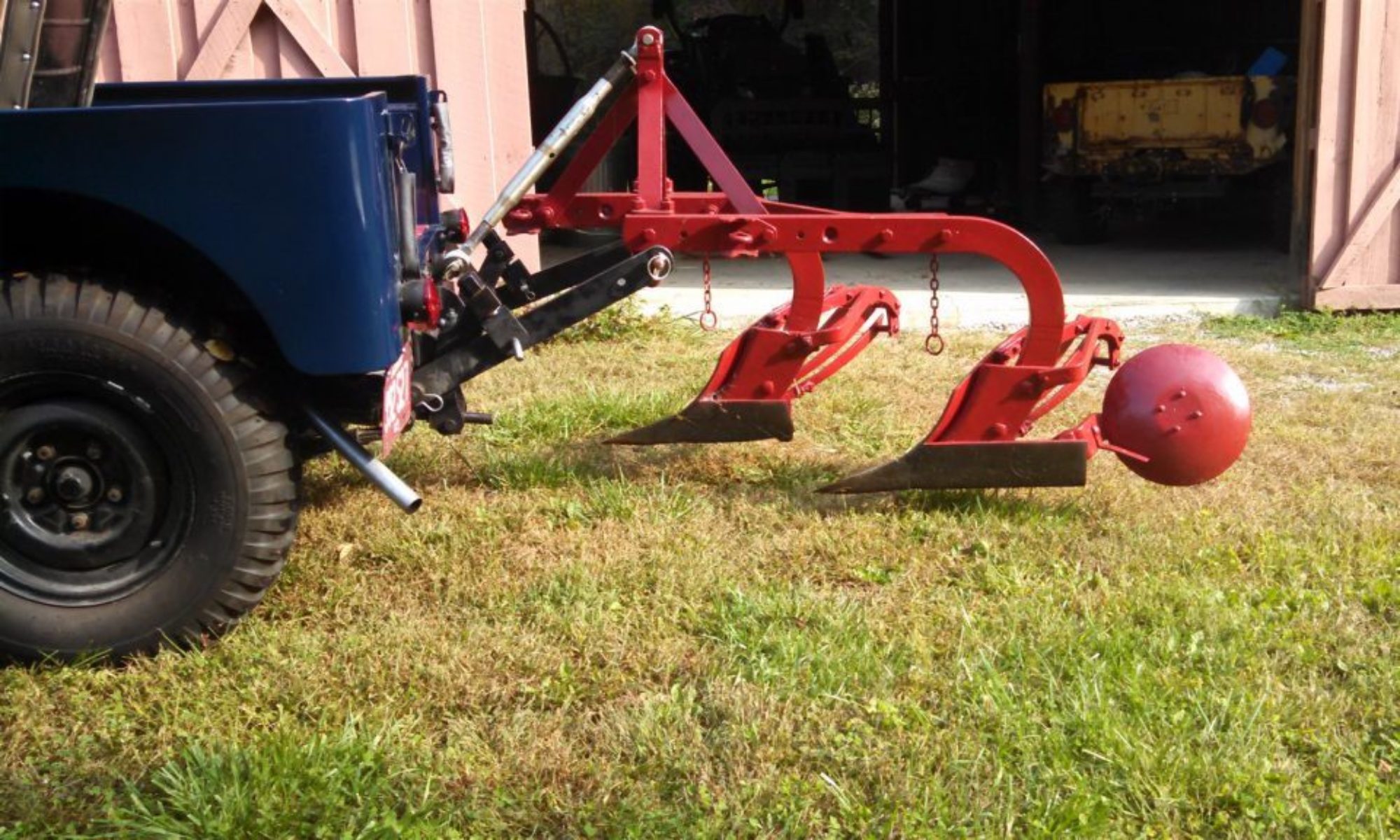Making of the Farm Jeep – Part 2

If there was ever a question about the role Willys expected the new CJ2a to play in the post-war world, it is made perfectly clear by the dash plate attached to every Jeep. On the left are a factory, water tower, and smokestacks, the symbols of American industry. On the right is the barn, windmill, and silo of the iconic American farm.[1] There was an official “Farm Jeep” model, but any post-war Jeep equipped to do farm work deserves that title. By simply bolting on a few parts, the Universal Jeep instantly became a farm tractor.
In Part 1 of the Farm Jeep story (see Dispatcher Volume 3, Number 3, Fall 2017), we looked at the development of the Love 3-point hydraulic lift. This lift, as designed by Jabez (J.B.) Love, would set the standard for the all “Jeep Approved” hydraulic lift systems that followed. The Love Lift not only made the CJ2a (and all the post-war models to follow) a useful farm tractor, it did so as a direct competitor to Ford and Ferguson tractors. These were the only tractors of the era with a “standard” 3-point hydraulic lift system[2].
In this article, we will look at Willys’ introduction of the Love hydraulic lift system and the formation of a new company that would play a major role in the Farm Jeep story. We will also look at the differences in the Love and Newgren designs that help to simplify their identification.
Enter Newlin and Green
Over at FarmJeep.com, we have been researching the Newgren Company since we acquired our lift way back in 2002. There seems to be little information available about the company and its founders. Like most privately held companies of the period, they were not required to publish financial data. Over the years we have found newspaper accounts announcing the formation of the company, but no real operational information. We have collected a number of Newgren advertisements, but these again don’t provide any production data. Recently, Bill Norris, responding to an information request we had posted online, shared a newspaper clipping from the August 21, 1946 “Toledo Blade.” It covers the announcement by Willys-Overland of a new hydraulic lift unit available for the Jeep. The article, reproduced here, is packed with facts, some of which contradict other reporting we have seen. It also contains an error (“push button control”} that is reproduced in other articles.
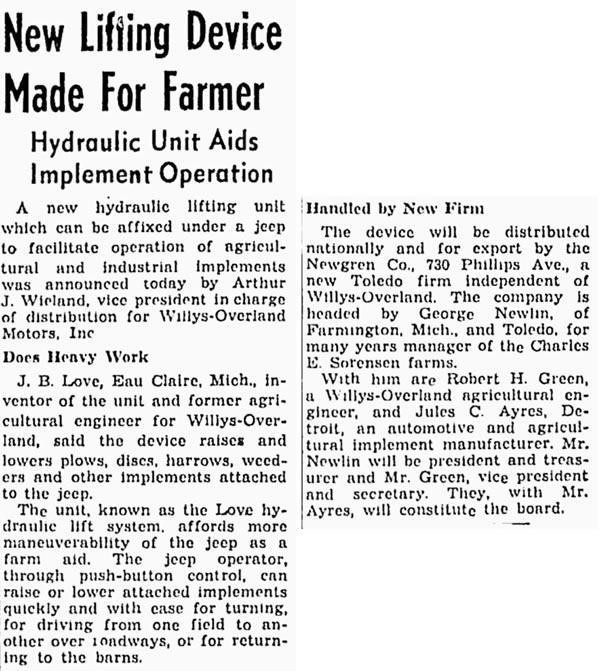
The article announces the first of the “Jeep Approved” lifts. While there were many different lift systems, both manufactured and custom built, for the Jeep, only four would be sold through dealerships or available from the factory. While the Love Lift will quickly be modified and sold as the Newgren Lift, we still count them as two distinct lifts. The other two “Jeep Approved” lifts, the Monroe Lift (manufactured by Monroe Automotive Equipment Company) and the Stratton Lift (manufactured by the Stratton Equipment Company) will be covered in future articles.
As stated above, almost all our knowledge about the Newgren company comes from newspaper articles. This article, as shown here, may have been among the first, since it was published in Willys’ home town. It is a good summary of the information that we have found thus far, but also adds new bits of information. For example, it states that J. B. Love was a “former agricultural engineer” with Willys. To this point we had only seen his position with Willys listed as a consultant. There is an article in Love’s hometown paper that referred to him holding a “position of importance” at Willys. Love had applied for a patent on his lift system for the new Jeep in 1945. We also know that Love continued to sell his version of the lift directly to the public until sometime in the early 1950s.
Here too, we have the announcement of the formation of the Newgren Company which would be the distributors of the lift. It introduces us to George Newlin and Robert Green, partners who gave the new company at least a part of their names.[3] We had assumed that Newlin, like Green, had worked for Willys. But we now learn that Newlin had been an employee of Charles Sorensen, managing one of his farms. Charles Sorensen headed Willys during the development of the post-war Jeep and we believe he was a major influence in the design of the hydraulic lift developed by Love. George Newlin’s presence is yet another example of how Sorensen had a major role in the overall development of Farm Jeep as a player in the tractor market. Newlin would have had extensive experience in testing the Ford-Ferguson system and associated implements while working for Sorensen. Sorensen was known to have used his farms as testing grounds while still at Ford.
Although the Newgren Company would exist for only a few years, it was a major part of the Farm Jeep story. There is little information available about the company’s size, organization or scope of activities. This same article gives some additional data with the introduction of a third player at Newgren, Jules C. Ayres, “an automotive and agricultural implement manufacturer.”
We have not found any information on Mr. Ayres, but this newspaper article does at least hint at the possibility of Newgren being more than just a distribution operation from the beginning of the company. Newgren would go on to offer a full line of implements for Jeeps with hydraulic lifts. Newgren did outsource its early plow production, but there is no indication of who manufactured the Newgren version of the Love Lift which they would be selling in just a few months. Perhaps Mr. Ayres or his company manufactured the lifts for Newgren.
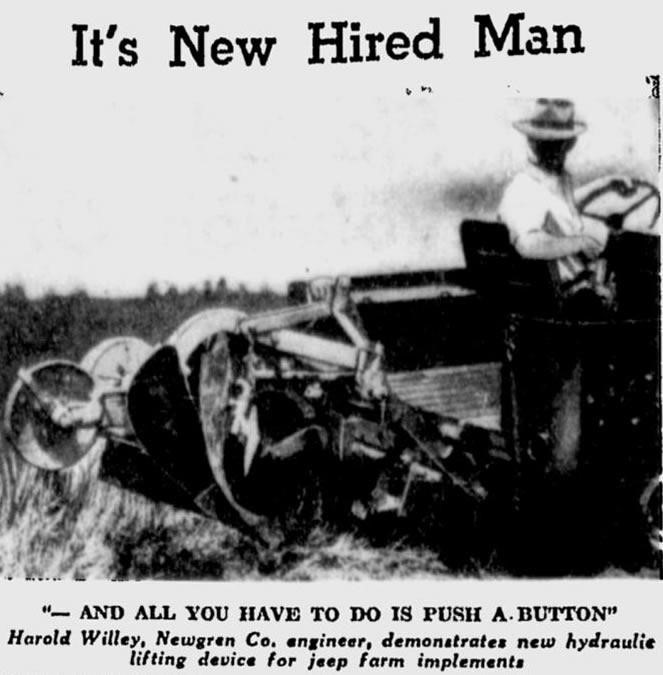
The picture accompanying the story also provides interesting information. Harold Willey is identified as a Newgren engineer. Does this mean that the later engineering changes made to the Love Lift were done in-house at Newgren? It also reinforces the idea of push-button control, which we know to be incorrect. That phrase will reappear in later press releases and stories. Both the Love and Newgren lifts used a lever between the front seats to control the raising and lowering of the lift.
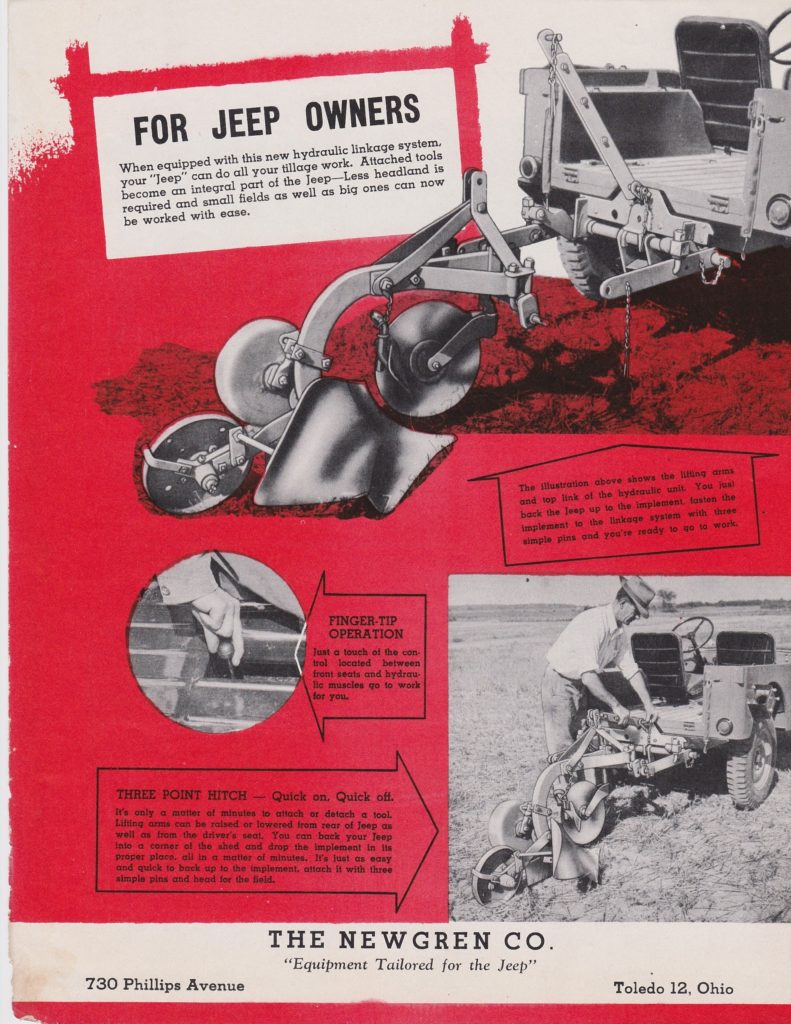
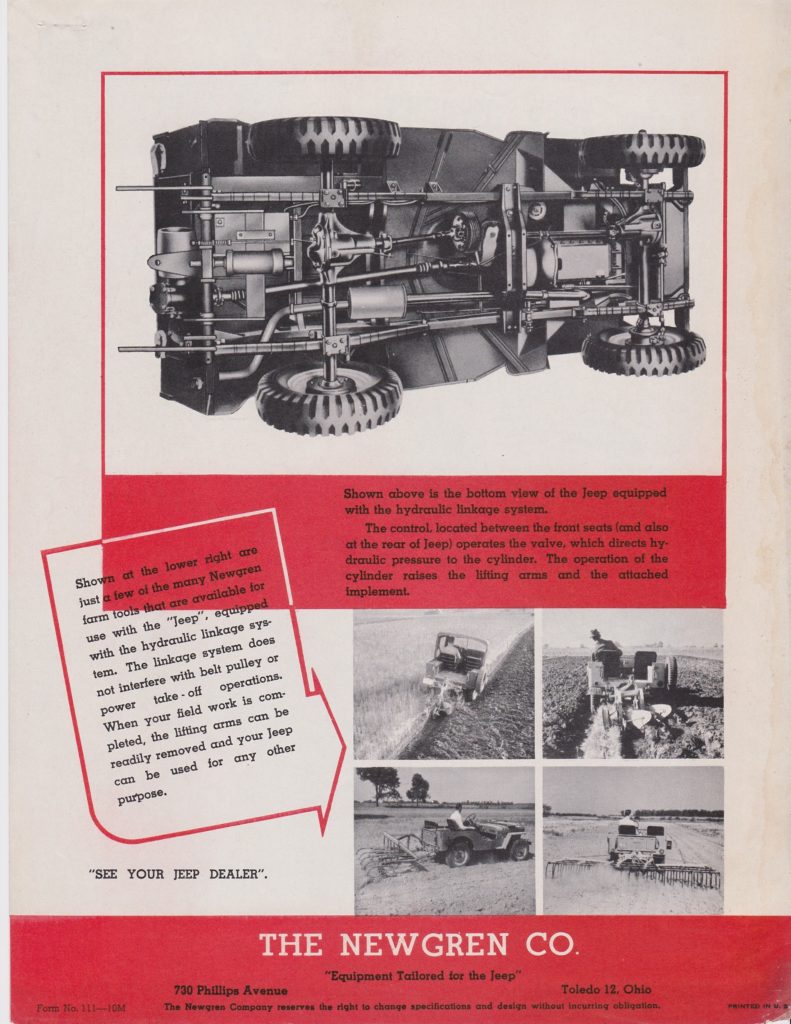
Changes to the Love Lift Design
By the time of the Willys’ announcement, Love had changed his original design to include a new frame and implement connecting arm design. The major change was the design of the frame used to attach the lift to the Jeep. The frame also contains the hydraulic cylinder, fluid reservoir/control valve, and the push block and lifting mechanism which raises the implement.
The implement connecting arms had been simplified to allow easy removal when using the Jeep for other jobs. An early flier showing both the rear of the Jeep and the underside of the Jeep with the lift installed provides details of the lift that Newgren was distributing.
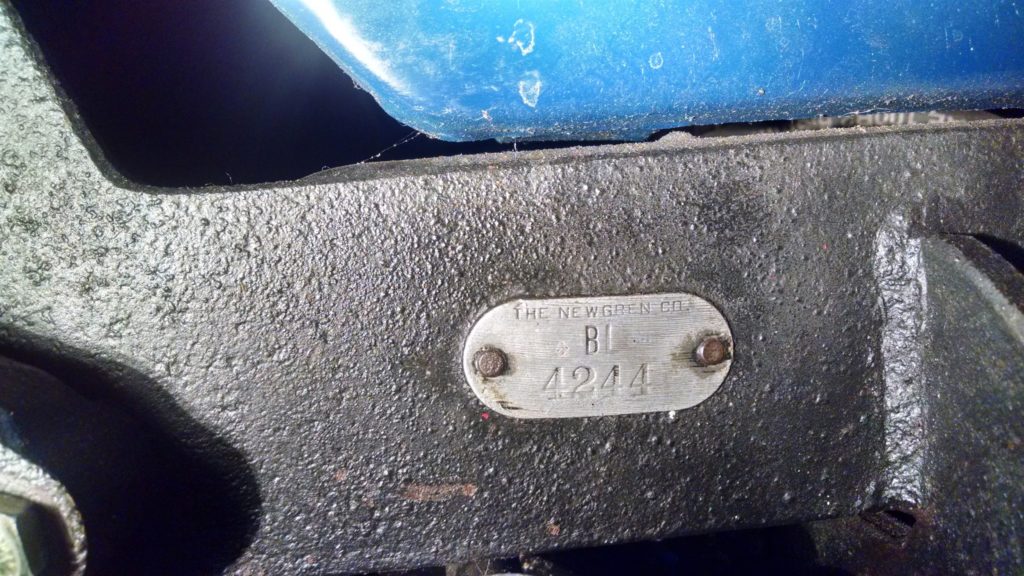
There is no clear evidence as to when the Newgren Company began manufacturing its version of the Love Lift, but we have assumed it to be in 1947. Newgren made at least three changes to this design and we believe they were made at the time production began. The rear member of the frame was extended and a serial number tag added. The simple design of the frame allows for quick assembly, using welded flat and round stock steel. While we don’t know the exact number of months of production, it appears that a substantial number of lift frames could have been produced.
The belt driven pump used on the Love Lift was replaced by a crankshaft driven pump. The first mounting bracket for the pump was a simple steel strap affair. Later, a cast mounting bracket was used. We don’t have comparative data on pump capacity, so we are unsure why this change was made. It is interesting to note that the pump Newgren used is the same as that used by International Harvester on its Model A and other tractors of the period. It is possible that it was a supplier issue that forced the change.[4]
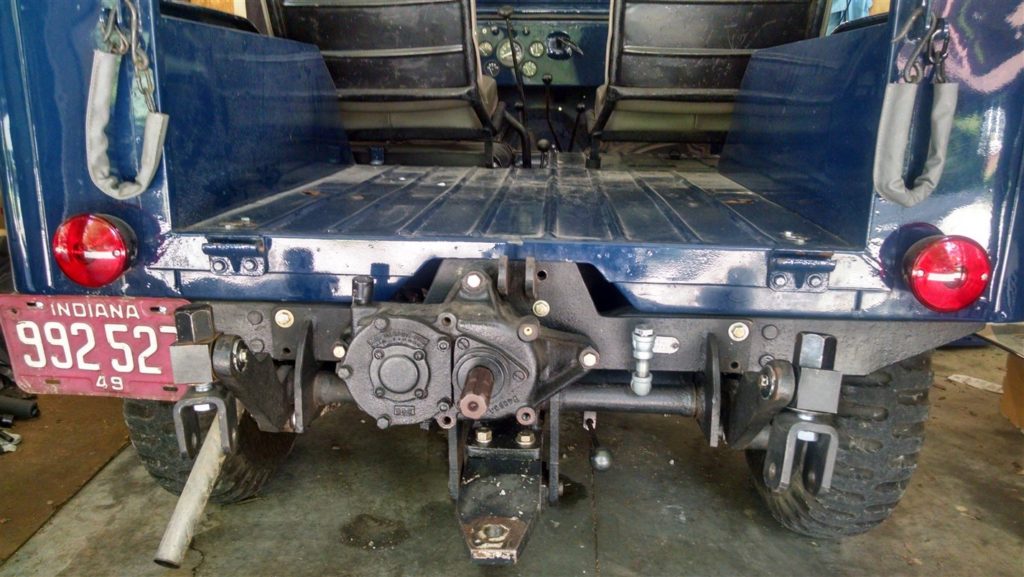
Another seemingly minor change was in the way the lift “short arms” linked to the long implement arms. Love had used a “L” shape connector. The Newgren engineers changed to an upside-down “U” connector. Newgren retained the adjusting nut that allowed for slightly raising or lowering of the individual implement arms. We assume this change was made to increase the strength of this critical lift point.
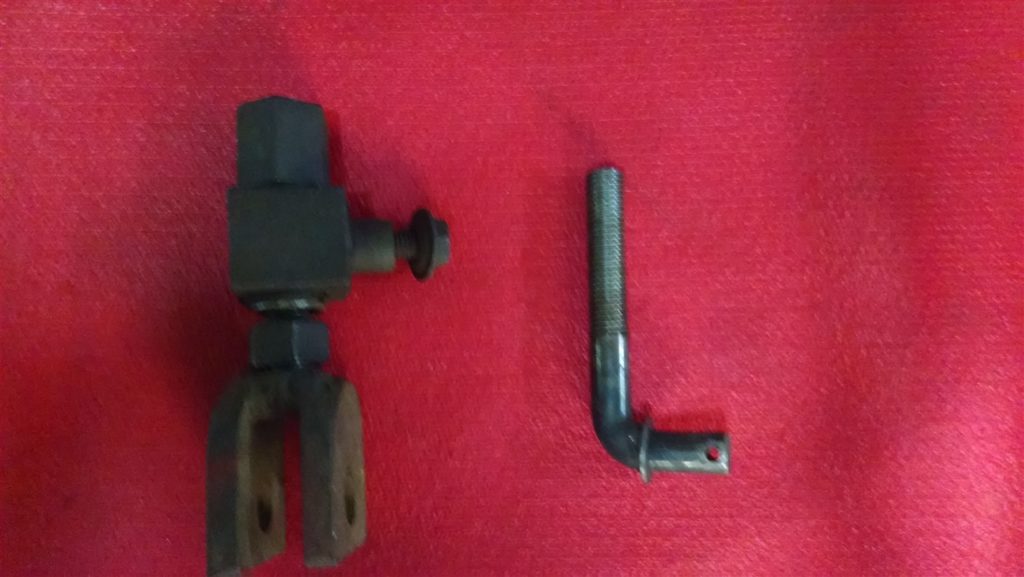
There is no evidence at this point that Love made any improvements to the model he sold to the public. In both cases the lifts are installed using the factory drawbar mounting points. No welding or modifications to the Jeep are required beyond cutting a slot in the floor between the seats for the control handle. The lifts came as a kit that could easily be installed by the dealer or the farmer in a couple of hours. Both versions of the lift cost, based on advertised prices, about $180.
Newgren’s ability to quickly produce a large number of lifts was based on the use of readily available parts. There are no manufacturer’s identification marks on the two different hydraulic cylinders that we believed were used during the production period. The cylinders appear to be of a common design of the period and modern day replacements are available. On the other hand, the control valve is a unique design and we have found no modern day equivalent. It does have an “S” and “PAT. PEND” stamped on the side, an indication that a patent search might provide additional information.
Not the end
The Newgren Lift was short lived, with lifts being produced for only a couple of years. Production of the lift must have started sometime after the Love announcement in 1946 and lasted until Newgren was purchased by Monroe Automotive Equipment Company in 1948. While Love continued to sell his version after Newgren production ended, we know of very few Love Lifts compared to the number of Newgren Lifts still in use.
Much of the rest of the Farm Jeep lift story belongs to Monroe. But the Newgren story is not complete. After being acquired by Monroe, the Newgren Company would end production of lifts, but would go on to distribute a full line of farm equipment. The Willys-Overland Equipment Books from 1946-1949 carried listings for two dozen Newgren implements and special equipment items. Even after the demise of the Newgren Company, plows and other equipment continued to be sold, without the Newgren tag, through Jeep dealerships. Ads from the mid-1950s show the Newgren designed plow being pulled by a CJ5.
Researching the Newgren Company continues by others. We still hope to find more information about this short lived, but none the less, major player in Farm Jeep history. We look forward to learning more. The story continues.
[1] A photo history of the dash plate can be found at http://www.cj-2a.com/oldsite/marks/dataplates/survey/index.html. What is unchanging in the pictures is the artwork. According to Jeep historian Keith Buckley, the industry representation is based on the Willys Toledo plant and the farm art is of the Canfield Farm, located just north of Charles Sorensen’s Cesor Farms.
[2] With the introduction of the Monroe Lift, to be detailed in the next article in this series, additional tractors and trucks would be able to use the Ford-Ferguson implements.
[3] Jerry Wittkop, retired engineer and curator of the Monroe Auto Equipment Company display at the Monroe County Museum, Monroe, Michigan, pronounces Newgren as “new-green.” Most folks say “new-grin.” Since Jerry was part of MAECO in the late 1940s, we assume he is correct.
[4] According to Monroe Auto Equipment Company historian Clint Dixon, the same PESCO pump was used for the Monroe Lift.
